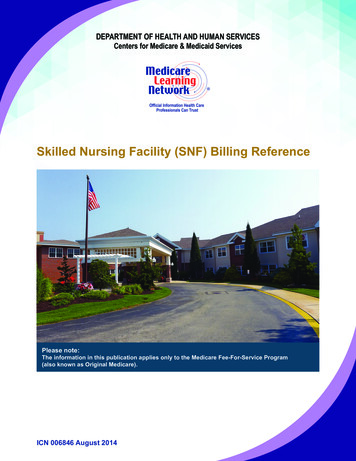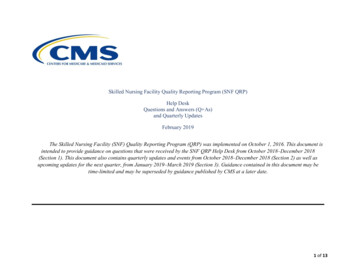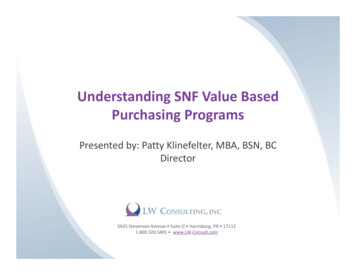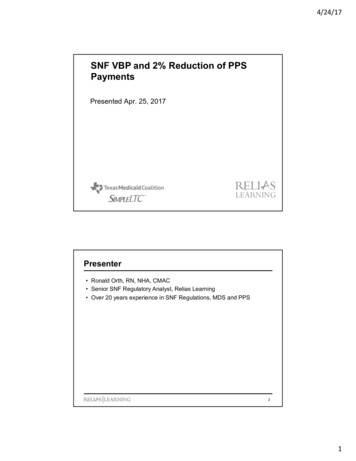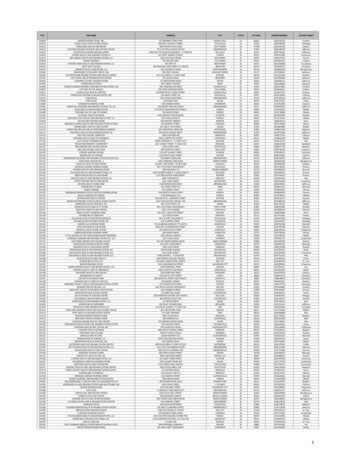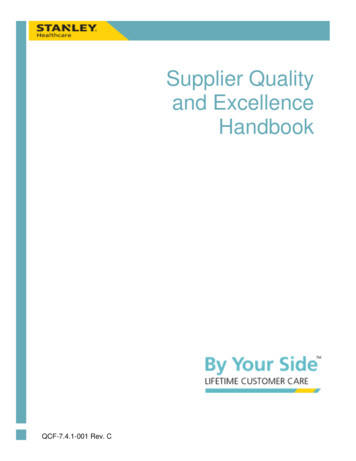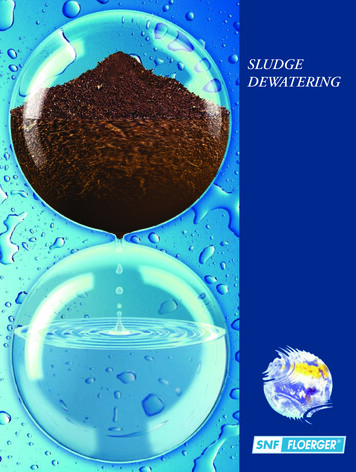
Transcription
SLUDGEDEWATERING
2Today, the treatment of water is a well-known process and is executed by state of the art techniques.The sludge resulting from this process represents the next challenge for the water treatment industry, inparticular the minimizing of its volume.This Sludge Dewatering handbook will present the key parameters to take into account in order to optimize sludge treatment with SNF Floerger’s organic polymers.INDEX1Sludge characterisation: . . . . . . . . . . . . . . . . . . . . . . . . . . . . . . . . . . . . . . . . . . . . . . . . . . .4i n d e x1.1.1.2.1.3.Origin of the sludge: . . . . . . . . . . . . . . . . . . . . . . . . . . . . . . . . . . . . . . . . . . . . . . . . . . . . . . . . . .4The different types of sludge: . . . . . . . . . . . . . . . . . . . . . . . . . . . . . . . . . . . . . . . . . . . . . . . . . . . .41.2.1.Primary sludge: . . . . . . . . . . . . . . . . . . . . . . . . . . . . . . . . . . . . . . . . . . . . . . . . . . . . . . . . . . . . .41.2.2.Biological sludge: . . . . . . . . . . . . . . . . . . . . . . . . . . . . . . . . . . . . . . . . . . . . . . . . . . . . . . . . . . .41.2.3.Mixed sludge: . . . . . . . . . . . . . . . . . . . . . . . . . . . . . . . . . . . . . . . . . . . . . . . . . . . . . . . . . . . . . .51.2.4.Digested sludge: . . . . . . . . . . . . . . . . . . . . . . . . . . . . . . . . . . . . . . . . . . . . . . . . . . . . . . . . . . . .51.2.5.Physico-chemical sludge: . . . . . . . . . . . . . . . . . . . . . . . . . . . . . . . . . . . . . . . . . . . . . . . . . . .61.2.6Mineral sludge: . . . . . . . . . . . . . . . . . . . . . . . . . . . . . . . . . . . . . . . . . . . . . . . . . . . . . . . . . . . . .6Parameters that influence the dewatering abilities of sludge: . . . . . . . . . . . . . . . . . . . . . . . .61.3.1.Concentration (g/l): . . . . . . . . . . . . . . . . . . . . . . . . . . . . . . . . . . . . . . . . . . . . . . . . . . . . . . . .61.3.2.The organic matter content (%): . . . . . . . . . . . . . . . . . . . . . . . . . . . . . . . . . . . . . . . . . . . . .61.3.3.The colloidal nature of the sludge: . . . . . . . . . . . . . . . . . . . . . . . . . . . . . . . . . . . . . . . . . .62 Dewatering aids: . . . . . . . . . . . . . . . . . . . . . . . . . . . . . . . . . . . . . . . . . . . . . . . . . . . . . . . . . .72.1.2.2.2.3.Mineral chemicals: . . . . . . . . . . . . . . . . . . . . . . . . . . . . . . . . . . . . . . . . . . . . . . . . . . . . . . . . . . . . . . 72.1.1.Iron salts: . . . . . . . . . . . . . . . . . . . . . . . . . . . . . . . . . . . . . . . . . . . . . . . . . . . . . . . . . . . . . . . . .72.1.2.Lime: . . . . . . . . . . . . . . . . . . . . . . . . . . . . . . . . . . . . . . . . . . . . . . . . . . . . . . . . . . . . . . . . . . . . . .7Organic chemicals: . . . . . . . . . . . . . . . . . . . . . . . . . . . . . . . . . . . . . . . . . . . . . . . . . . . . . . . . . . . . . .82.2.1.Flocculation mechanism: . . . . . . . . . . . . . . . . . . . . . . . . . . . . . . . . . . . . . . . . . . . . . . . . . . .82.2.2.Destabilized particles: . . . . . . . . . . . . . . . . . . . . . . . . . . . . . . . . . . . . . . . . . . . . . . . . . . . . .8Parameters of the organic chemicals that will influence dewatering: . . . . . . . . . . . . . . . . .92.3.1.The type of charge ( or - ): . . . . . . . . . . . . . . . . . . . . . . . . . . . . . . . . . . . . . . . . . . . . . . . .92.3.2.The charge density (%): . . . . . . . . . . . . . . . . . . . . . . . . . . . . . . . . . . . . . . . . . . . . . . . . . . . . .92.3.3.The molecular weight (MW): . . . . . . . . . . . . . . . . . . . . . . . . . . . . . . . . . . . . . . . . . . . . . . .102.3.4.The molecular structure: . . . . . . . . . . . . . . . . . . . . . . . . . . . . . . . . . . . . . . . . . . . . . . . . . .102.3.5.The type of monomer: . . . . . . . . . . . . . . . . . . . . . . . . . . . . . . . . . . . . . . . . . . . . . . . . . . . .103 Dynamic thickening: . . . . . . . . . . . . . . . . . . . . . . . . . . . . . . . . . . . . . . . . . . . . . . . . . . . . . 113.1.3.2.3.3.3.4.Flotation: . . . . . . . . . . . . . . . . . . . . . . . . . . . . . . . . . . . . . . . . . . . . . . . . . . . . . . . . . . . . . . . . . . . . . . 113.1.1.Indirect flotation: . . . . . . . . . . . . . . . . . . . . . . . . . . . . . . . . . . . . . . . . . . . . . . . . . . . . . . . . . 123.1.2.Direct flotation: . . . . . . . . . . . . . . . . . . . . . . . . . . . . . . . . . . . . . . . . . . . . . . . . . . . . . . . . . . . 113.1.3.Sludge conditioning before flotation: . . . . . . . . . . . . . . . . . . . . . . . . . . . . . . . . . . . . . . . 12Thickening table: . . . . . . . . . . . . . . . . . . . . . . . . . . . . . . . . . . . . . . . . . . . . . . . . . . . . . . . . . . . . . . . 123.2.1.Operating principle: . . . . . . . . . . . . . . . . . . . . . . . . . . . . . . . . . . . . . . . . . . . . . . . . . . . . . . . 133.2.2.Sludge conditioning before thickening table: . . . . . . . . . . . . . . . . . . . . . . . . . . . . . . . . 13Thickening drum, screw drum: . . . . . . . . . . . . . . . . . . . . . . . . . . . . . . . . . . . . . . . . . . . . . . . . . . . 143.3.1.Operating principle: . . . . . . . . . . . . . . . . . . . . . . . . . . . . . . . . . . . . . . . . . . . . . . . . . . . . . . . 143.3.2.Sludge conditioning before thickening drum: . . . . . . . . . . . . . . . . . . . . . . . . . . . . . . . . 14Centrifuge: . . . . . . . . . . . . . . . . . . . . . . . . . . . . . . . . . . . . . . . . . . . . . . . . . . . . . . . . . . . . . . . . . . . . 153.4.1.Operating principle: . . . . . . . . . . . . . . . . . . . . . . . . . . . . . . . . . . . . . . . . . . . . . . . . . . . . . . . 153.4.2.Sludge conditioning before centrifuge: . . . . . . . . . . . . . . . . . . . . . . . . . . . . . . . . . . . . . . 15
34Belt filter dewatering: . . . . . . . . . . . . . . . . . . . . . . . . . . . . . . . . . . . . . . . . . . . . . . . . . . . 164.1.4.2.4.3.4.4.Equipment description and operating principle: . . . . . . . . . . . . . . . . . . . . . . . . . . . . . . . . . . . 16Lab tests: . . . . . . . . . . . . . . . . . . . . . . . . . . . . . . . . . . . . . . . . . . . . . . . . . . . . . . . . . . . . . . . . . . . . . . 174.2.1.Sampling: . . . . . . . . . . . . . . . . . . . . . . . . . . . . . . . . . . . . . . . . . . . . . . . . . . . . . . . . . . . . . . . . . 174.2.2.Laboratory equipment: . . . . . . . . . . . . . . . . . . . . . . . . . . . . . . . . . . . . . . . . . . . . . . . . . . . . 174.2.3.Test procedures: . . . . . . . . . . . . . . . . . . . . . . . . . . . . . . . . . . . . . . . . . . . . . . . . . . . . . . . . . . . 184.2.4.Parameters to check and analysis of the results: . . . . . . . . . . . . . . . . . . . . . . . . . . . . 18Plant trials: . . . . . . . . . . . . . . . . . . . . . . . . . . . . . . . . . . . . . . . . . . . . . . . . . . . . . . . . . . . . . . . . . . . . 194.3.1.Setting up a trial: . . . . . . . . . . . . . . . . . . . . . . . . . . . . . . . . . . . . . . . . . . . . . . . . . . . . . . . . . 194.3.2.Parameters to follow and analysis of results: . . . . . . . . . . . . . . . . . . . . . . . . . . . . . . . 19Optimizing belt filters: . . . . . . . . . . . . . . . . . . . . . . . . . . . . . . . . . . . . . . . . . . . . . . . . . . . . . . . . . 194.4.1.Bad drainage: . . . . . . . . . . . . . . . . . . . . . . . . . . . . . . . . . . . . . . . . . . . . . . . . . . . . . . . . . . . . 204.4.2.Sludge creeping: . . . . . . . . . . . . . . . . . . . . . . . . . . . . . . . . . . . . . . . . . . . . . . . . . . . . . . . . . . 204.4.3.Low cake dryness: . . . . . . . . . . . . . . . . . . . . . . . . . . . . . . . . . . . . . . . . . . . . . . . . . . . . . . . . . 214.4.4.Summary of the adjustable parameters: . . . . . . . . . . . . . . . . . . . . . . . . . . . . . . . . . . . . 215 Centrifuge dewatering: . . . . . . . . . . . . . . . . . . . . . . . . . . . . . . . . . . . . . . . . . . . . . . . . . . 225.3.5.4.Equipment description and operating principle: . . . . . . . . . . . . . . . . . . . . . . . . . . . . . . . . . . 22Lab tests: . . . . . . . . . . . . . . . . . . . . . . . . . . . . . . . . . . . . . . . . . . . . . . . . . . . . . . . . . . . . . . . . . . . . . . 235.2.1.Sampling: . . . . . . . . . . . . . . . . . . . . . . . . . . . . . . . . . . . . . . . . . . . . . . . . . . . . . . . . . . . . . . . . 235.2.2.Laboratory equipment: . . . . . . . . . . . . . . . . . . . . . . . . . . . . . . . . . . . . . . . . . . . . . . . . . . . 245.2.3.Test procedures: . . . . . . . . . . . . . . . . . . . . . . . . . . . . . . . . . . . . . . . . . . . . . . . . . . . . . . . . . . 245.2.4.Parameters to check and analysis of the results: . . . . . . . . . . . . . . . . . . . . . . . . . . . . 25Plant trials: . . . . . . . . . . . . . . . . . . . . . . . . . . . . . . . . . . . . . . . . . . . . . . . . . . . . . . . . . . . . . . . . . . . . 255.3.1.Setting up a trial: . . . . . . . . . . . . . . . . . . . . . . . . . . . . . . . . . . . . . . . . . . . . . . . . . . . . . . . . . 255.3.2.Parameters to follow and analysis of results: . . . . . . . . . . . . . . . . . . . . . . . . . . . . . . . 25Optimizing centrifuges: . . . . . . . . . . . . . . . . . . . . . . . . . . . . . . . . . . . . . . . . . . . . . . . . . . . . . . . . . 265.4.1.Black centrate: . . . . . . . . . . . . . . . . . . . . . . . . . . . . . . . . . . . . . . . . . . . . . . . . . . . . . . . . . . . 265.4.2.Gray, foaming centrate: . . . . . . . . . . . . . . . . . . . . . . . . . . . . . . . . . . . . . . . . . . . . . . . . . . . 265.4.3.Low cake dryness: . . . . . . . . . . . . . . . . . . . . . . . . . . . . . . . . . . . . . . . . . . . . . . . . . . . . . . . . 275.4.4.Summary of the adjustable parameters: . . . . . . . . . . . . . . . . . . . . . . . . . . . . . . . . . . . 276 Frame filter press dewatering: . . . . . . . . . . . . . . . . . . . . . . . . . . . . . . . . . . . . . . . . . . . . 286.1.6.2.6.3.6.4.Equipment description and operating principle: . . . . . . . . . . . . . . . . . . . . . . . . . . . . . . . . . . 28Lab tests: . . . . . . . . . . . . . . . . . . . . . . . . . . . . . . . . . . . . . . . . . . . . . . . . . . . . . . . . . . . . . . . . . . . . . . 306.2.1.Sampling: . . . . . . . . . . . . . . . . . . . . . . . . . . . . . . . . . . . . . . . . . . . . . . . . . . . . . . . . . . . . . . . . 306.2.2.Laboratory equipment: . . . . . . . . . . . . . . . . . . . . . . . . . . . . . . . . . . . . . . . . . . . . . . . . . . . 306.2.3.Test procedures: . . . . . . . . . . . . . . . . . . . . . . . . . . . . . . . . . . . . . . . . . . . . . . . . . . . . . . . . . . 306.2.4.Parameters to check and analysis of the results: . . . . . . . . . . . . . . . . . . . . . . . . . . . . 31Plant trials: . . . . . . . . . . . . . . . . . . . . . . . . . . . . . . . . . . . . . . . . . . . . . . . . . . . . . . . . . . . . . . . . . . . . 326.3.1.Setting up a trial: . . . . . . . . . . . . . . . . . . . . . . . . . . . . . . . . . . . . . . . . . . . . . . . . . . . . . . . . . 326.3.2.Parameters to follow and analysis of results: . . . . . . . . . . . . . . . . . . . . . . . . . . . . . . . 32Optimizing frame filter press: . . . . . . . . . . . . . . . . . . . . . . . . . . . . . . . . . . . . . . . . . . . . . . . . . . . 326.4.1.Sticky cakes: . . . . . . . . . . . . . . . . . . . . . . . . . . . . . . . . . . . . . . . . . . . . . . . . . . . . . . . . . . . . . . 336.4.2.Cloth plugging: . . . . . . . . . . . . . . . . . . . . . . . . . . . . . . . . . . . . . . . . . . . . . . . . . . . . . . . . . . . . 336.4.3.Polymer efficiency loss: . . . . . . . . . . . . . . . . . . . . . . . . . . . . . . . . . . . . . . . . . . . . . . . . . . . . 33i n d e x5.1.5.2.
41S L U D G Ec h a r a c t e r i s a t i o n1D E W A T ESludge characterisationThere are several types of sludge that have specific characteristics that will influence: The choice in conditioning chemical (cationic flocculant, ferric chloride, lime ) The choice in the dewatering equipment to be used (filtration, centrifuge )These choices will also depend on the final use of the sludge (incineration, agriculturalspreading )1.1. Origin of the sludge:During the course of the water treatment, products coming from the pollution are extractedwhile the treated water is released in the environment.Amongst these products coming from the pollution one can distinguish: Particles that decant naturally or that come from the physico-chemical treatment Excess micro-organisms coming from the dissolved organic matter treatment Mineral matter that is non biodegradableAll these products are suspended in more or less concentrated forms and the resulting liquidis called sludge.s l u d g e1.2. The different types of sludge:1.2.1. Primary sludge:Primary sludge comes from the settling process. It is therefore made of easily decantablesuspended particles: large and/or dense particles.It has a low level of Volatile Solids content (VS around 55% to 60%) and its dewateringability is excellent.It is also very easy to concentrate this type of sludge with a static thickening step just before dewatering. The drawback is that this sludge ferments very easily.1.2.2. Biological sludge:Biological sludge comes from the biological treatment of the wastewater. It is made of amixture of microorganisms. These microorganisms, mainly bacteria, amalgamate inbacterial flocs through the synthesis of exo-polymers. A simple decantation in the clarifierwill easily separate the bacterial flocs from the treated water.Only part of this settled sludge is sent to dewatering: the excess biological sludge; part of itis recirculated to maintain the bacterial population in the reactor.
5R I N G1.2.3. Mixed sludge:Mixed sludge is a blend of primary and biological sludges. The blending ratio is often asfollows: 35% to 4
filter press applications. Organic chemicals such as coagulants and flocculants. The most common type of flocculants encountered are cationic in nature. 2.1. Mineral chemicals: 2.1.1. Iron salts: Ferric Chlorideand Iron Chloro-Sulfateare mainly used in conjunction with lime to condi-tion the sludge before a filter press.
